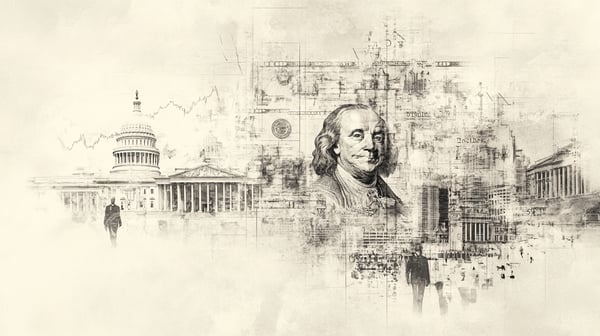The global economy at a crossroads

The global trading system stands at a crossroads, as outlined in Stephen Miran’s study, A User’s Guide to Restructuring the Global Trading System. The study suggests that the persistent overvaluation of the U.S. dollar, driven by the inelastic demand for reserve assets, is at the heart of economic imbalances. As the global economy expands, the burden on the United States to supply these reserve assets while also maintaining its defense commitments becomes increasingly unsustainable.
The theoretical underpinnings of Miran’s analysis are rooted in the well-known Triffin Dilemma, which argues that a global reserve currency-issuing nation must run persistent trade deficits to meet global liquidity needs. This structure naturally leads to an overvalued dollar, making U.S. exports less competitive while simultaneously flooding the U.S. economy with cheap imports. Over time, this erodes the manufacturing base and shifts economic dominance toward financialized sectors. This imbalance is not a new phenomenon but has been exacerbated by policies that encourage capital flows into U.S. assets rather than productive domestic investment. The result is a structurally weaker economy in which working-class Americans bear the brunt of dislocations while financial elites benefit from asset price inflation. The study further highlights how past attempts at trade adjustments, particularly through tariff implementation, have often been offset by currency movements. This mechanism makes it possible for tariffs to raise revenue without significantly increasing inflation, provided currency values adjust in response.
Miran delves into the role of tariffs as a potential policy tool to correct trade imbalances. Contrary to the mainstream narrative, which views tariffs as inherently inflationary, the study argues that they can be structured in a way that minimizes inflationary impact. The 2018-2019 tariff measures imposed during the Trump administration are cited as evidence, where tariffs were effectively counteracted by currency appreciation, reducing their overall economic distortion. The real burden of these tariffs was borne by foreign producers rather than domestic consumers. However, the study acknowledges that the success of tariffs depends on their implementation strategy. A gradual scaling approach, particularly when intertwined with national security concerns, could be more effective than blanket impositions. Tariffs alone, however, cannot resolve trade imbalances unless they are paired with deliberate currency management strategies. Tariffs, when paired with currency interventions, could generate revenue while forcing other countries to contribute more to the global reserve system rather than relying disproportionately on the U.S.
Currency policy presents a different set of challenges. While past U.S. administrations have sought multilateral currency adjustments, the study argues that unilateral measures are both possible and necessary. One such measure includes direct intervention in currency markets to counteract foreign exchange manipulation by countries that deliberately undervalue their currencies to maintain export competitiveness. Another option is the strategic accumulation of reserve assets by the U.S. government to influence exchange rates indirectly. The study recognizes that these measures carry risks, particularly in terms of global market volatility and potential retaliation from other nations. However, it argues that without currency reform, any attempt at rebalancing trade through tariffs will be ineffective. The broader implication is that the current global monetary system disproportionately benefits surplus nations that manipulate their exchange rates while leaving the U.S. to bear the cost of maintaining global liquidity.
However, if we dig deeper, the issue isn’t just an overvalued U.S. dollar or a set of trade imbalances that can be resolved with tariffs or currency interventions — it’s the very structure of the global monetary system itself. While Miran’s analysis assumes that policymakers have direct control over the dollar’s valuation and trade balances, the study completely overlooks the reality of the Eurodollar system. This vast, unregulated offshore network of dollar liabilities and derivatives functions independently of the Federal Reserve and U.S. authorities. That means the factors driving global dollar liquidity are not determined by Washington’s policy choices but by an intricate web of global banks, financial institutions, and credit markets. If we don’t understand how this system operates, any attempt to manipulate trade balances or currency values will amount to little more than wishful thinking.
The biggest problem lies in the fact that policymakers have consistently misunderstood how money is actually created and distributed within this offshore dollar system. Take quantitative easing (QE) as an example. Central banks assumed that by injecting liquidity into the system through bank reserves, they could stimulate lending and economic growth. But history has demonstrated time and time again, QE did not translate into broader money supply growth because reserves are not the driving force behind credit creation. Instead, the real source of global dollar liquidity lies in the willingness of private financial institutions to create and distribute credit in offshore markets. This is why, despite the Federal Reserve’s best efforts, we continue to see liquidity shortages, financial instability, and a dollar system that doesn’t behave the way central bankers expect it to. This raises a serious concern: if even the world’s most powerful central bank cannot influence global dollar flows effectively, then how can trade policy tools like tariffs or exchange rate adjustments be expected to work?
Another crucial flaw in Miran’s argument is the belief that the U.S. can unilaterally control global dollar flows through trade policy. The truth is, the dollar’s dominance is not a product of explicit government policy but of market-driven financial networks that use dollar-denominated assets as the primary medium of global exchange. As long as international institutions view the dollar as the most reliable unit of account and store of value, demand for dollars will remain high, regardless of tariffs or government intervention. This reality makes it clear that targeting trade deficits through policy measures like tariffs is an oversimplified solution to a much more complex problem. Worse, such interventions could backfire, creating instability in offshore funding markets and disrupting the very liquidity mechanisms that keep the global economy functioning.
We need to accept the uncomfortable truth: modern monetary systems are not centrally controlled but rather decentralized, evolving networks. Unless policymakers recognize this, we will continue seeing economic policies that fail to deliver the intended results, while the real drivers of global finance remain unchecked.
Moving forward, restructuring the global trading system requires an approach that acknowledges both the constraints of the Eurodollar system and the need for policy innovation. One potential solution lies in digital currencies and blockchain technology. Cryptocurrencies, particularly stablecoins backed by diverse reserves, offer a decentralized alternative to the existing dollar-dominated system. By reducing reliance on centralized monetary authorities, a well-structured digital reserve system could distribute liquidity more equitably while reducing the distortions caused by artificial currency pegs. However, this requires significant regulatory coordination to ensure stability and prevent excessive speculation. A carefully designed digital infrastructure, supported by artificial intelligence, could improve market efficiency by automating liquidity distribution and reducing the systemic risk posed by unregulated shadow banking activities.
AI also presents an opportunity to enhance financial system transparency. The current Eurodollar system operates in opaque networks where risk is difficult to assess in real time. Machine learning algorithms, if properly integrated, could monitor global liquidity conditions, identify stress points in the financial system, and offer predictive insights to mitigate crises before they occur. By leveraging AI-driven analytics, policymakers could gain a clearer picture of international capital flows and implement preemptive measures to prevent liquidity shocks. This would allow for a more responsive and adaptive monetary framework rather than relying on outdated policy tools that often react too late to emerging crises.
Regulatory reforms must accompany these technological advancements. The fragmentation of the current system, where offshore dollar markets operate outside traditional regulatory oversight, makes it nearly impossible for any single entity to control financial stability effectively. A collaborative regulatory framework that includes input from major economic blocs, central banks, and private sector stakeholders is essential. This should focus on harmonizing capital requirements for offshore banks, improving transparency in derivatives markets, and creating contingency mechanisms for liquidity crises. Without regulatory coordination, even the most sophisticated financial innovations risk being co-opted by existing power structures, leading to further entrenchment of the status quo rather than genuine reform.
Ultimately, any vision of restructuring the global trade system underestimates the complexity of the financial system that underpins trade imbalances. While tariffs and currency adjustments may provide temporary relief, a sustainable solution requires deeper structural reforms that integrate digital currency innovations, AI-driven financial monitoring, and enhanced regulatory frameworks. The future of the global economy will depend not only on rebalancing trade flows but on reimagining the very foundation of international monetary exchange.




